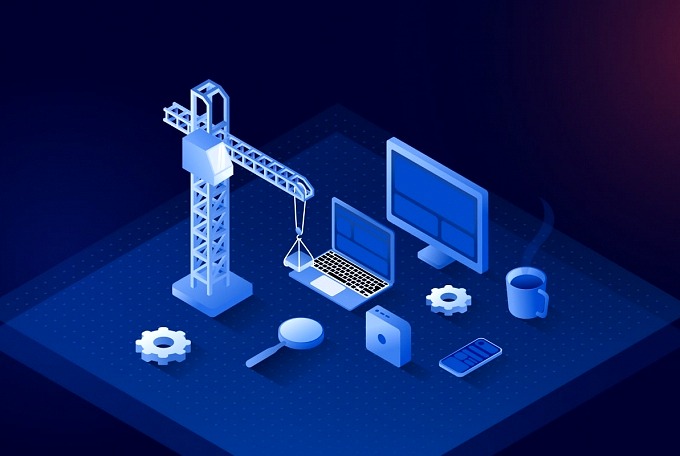Cloud services give every business access to the technological possibilities that in the past were reserved for just the richest of enterprises. In spite of this, only those companies that understand the essence of a cloud native approach in software development are going to gain a competitive advantage. Find out what cloud architecture is, and what you should pay attention to, when developing digital products intended to match the requirements of the modern market.
Although cloud architecture development is nothing new, only a few companies can boast a comprehensive implementation. Those businesses that have taken full advantage of the cloud native approach have achieved global success.
What are cloud native and cloud architecture?
The concept of cloud architecture is based on, and is inextricably linked to, the cloud native approach. In order to understand cloud architecture, you should first get to know the principles of cloud native. The Cloud Native Computing Foundation (CNCF), an organisation that promotes open source solutions for building cloud architecture, defines cloud native as “technologies that empower organisations to build and run scalable applications in modern dynamic cloud environments, such as in public, private and hybrid clouds”. Check the difference between private, public and hybrid clouds.
Cloud native solutions encompass:
- containers,
- microservices,
- service mesh,
- immutable infrastructure,
- declarative APIs.
The founder of Kubernetes (a platform for management, automating and scaling of containerised applications) presents an interesting definition. According to Joe Beda, cloud native is structuring teams, culture and technology to utilise automation and architectures to manage complexity and unlock velocity. All of this is supposed to increase the performance of both the people associated with IT projects and the technology itself.
Find out more about cloud native and learn how you can use this approach when giving access to software in an SaaS model.
When using cloud solutions and developing architecture, you should take into account the perspective of the end user, the application owner, and the entire industry. Focusing on customer satisfaction is what connects all these points. Technology has ceased to be most important in IT projects. It is crucial to meet the needs of the target customers from whom we earn. One reason why this phenomenon has been on the rise is increased competition. In the past, the majority of advanced applications worked similarly to monopolies. Promoting information technologies has resulted in a dynamic growth in digital products. For this reason, software owners compete with each other to create functionalities that respond best to the expectations of customers.
The dynamic growth in software development has created a unique system of learning in many software houses. Experience is built from the sheer number of projects. Customers can choose from a wide array of solutions in order to test the operation of a system before bearing significant costs. This vastly reduces the risks connected with new enterprises.
At Stepwise we use best practices in this respect, constantly developing our competences, and paying particular attention to communication with partners, to complete projects smoothly. In this way, we can immediately respond to every customer request and adjust the direction of development. Learn what makes democratic software development at Stepwise unique or contact us to discuss our areas of potential cooperation.
Creating software in compliance with cloud architecture principles comprises Agile development, namely small, frequent and quick changes to the software. In the past, developers used to fulfil projects in strict accordance to the initial requirements. These days, understanding the shape of a final product as a living and flexible organism is of key significance.
In cloud architecture, open source development and automation are essential. Open source technologies have contributed to the spread of cloud architecture. Today, nearly every company can get access to advanced solutions. Process automation can alleviate companies from employing additional staff for system operations. Applications are created in order to maximise activities that do not require human intervention.
What is cloud architecture?
Cloud architecture is a method of integrating multiple technologies to create a coherent infrastructure and IT system in the cloud, which then provides an optimum platform for developing, managing, providing access and scaling applications.
In order to thoroughly understand this issue, we can draw an analogy with the automotive industry. In car production, “cloud infrastructure” would mean the production line, tools and essential materials, while “cloud architecture” would constitute the car construction project and the manner of production.
Cloud architecture is a specific project and plan of the essential cloud resources (and the connections between them) aimed at obtaining innovative technological solutions. The cloud services each have their unique cloud architectures, just like various car models have their unique construction plans.
Cloud architecture consists of many different components, and creating these projects properly requires extensive experience. The main division of architecture assumes that there are 4 basic cloud architecture pillars:
1. Infrastructure
2. Data
3. Security
4. Integration
According to the cloud architecture principles, when we create and develop an application, we focus on certain features to ensure that the final software meets the cloud native requirements. An outcome-product that should be handled as a living and changeable organism is essential, rather than a fixed project that excludes the possibility of modifying the initial assumptions.
All experienced companies are aware of the possible errors in software, and that the market and customer expectations sometimes change in a moment. Cloud native assumes that our attention is directed to the product and continuous development, rather than to a path to achieving the goal.
Examples of cloud architecture uses
Walmart
This American retail corporation operates a chain of supermarkets, is strongly developing cloud technologies, and is using the advantages of hybrid cloud by combining private data centres with public cloud provider services and edge computing software in their stores. Dynamic expansion and new companies acquisitions (for their software) have motivated the management team to create efficient cloud architecture that are able to combine the current cutting edge system with the software from the acquired companies. The Walmart approach does not assume simply “adding” old software. The acquired software is modified and adjusted to fit cloud technology to cooperate effectively with the other components of the entire system.
Walmart is a global leader in implementing multichannel and omnichannel strategies that are associated with combining marketing, sales and customer service activities, into a coherent and compatible system by means of a range channels. To achieve this, Walmart uses the cloud native approach, which guarantees streamlined customer purchasing irrespective of where and how this is done. Every year Walmart willingly shares their experiences with the industry, presenting their successes and, more importantly, also their failures and the impact on the entire system, along with the costs of fixing them.
As one of the largest cloud service providers, Google is a perfect example of using cloud architecture, and is an exceptionally rich source of knowledge in this respect. Google has been developing their own infrastructure and taking part in multiple open source projects for years. As a result, all Google Cloud Platform users can use best cloud native practices related to cloud software development, cyber-protection of applications, data analysis, and implementation of machine learning and artificial intelligence solutions.
Google has a network of data centres worldwide, which ensures a high level of application availability in the cloud, quick data transfers and increased security of user software backups. Well-designed cloud architecture is of key significance for digital products supporting business, which is why Google uses, develops and shares their knowledge in the form of useful educational materials.

The main cloud architecture principles
Cloud architecture and the cloud native approach used in software development are among the key success factors in the competitive digitalised market. In the current business environment, those companies that make it big are able to deliver to their recipients or customers positive experiences at all points of contact between the consumer and the brand. Planning, building, implementing and developing native applications should be based on solid foundations.
4 main cloud architecture principles
1. Responsiveness – indicates how efficiently the system responds to customer expectations and market changes. Responsiveness can also be understood as the ability to quickly adapt software to changes, not only here and now, but also in the future. The cloud native approach enables creating future proof applications that are considerably easier to scale than in other traditional approaches.
2. Lack of disruption to operation – disruptions have a negative influence on the application itself and the company reputation. Bad user experiences translate into bad marketing. PR connected with system reliability is significant for business, particularly when it comes to advanced systems associated for example with payments. Even for smaller companies, an appropriate cloud architecture is an insurance policy for the future and a guarantee of smooth scaling.
3. Building relationships through technology – security, privacy and accessibility impact the maintenance of positive relationships with individual and business customers. Building relationships through technology is an exceptionally sensitive mechanism, requiring not only specialised IT knowledge, but also highly developed soft competences, even in technical team members. What is more, the responsibility for relationships can be shared between the various organisation departments, and also between totally different companies that apparently have nothing in common.
Allegro
Some time ago a fire at OVH in France destroyed a lot of terabytes of data. At a nearby OVH centre that was blocked as well, their Baselinker system was located – a service for integrating the e-commerce and sales management platform used by many e-sellers on Allegro, the largest Polish e-commerce platform (the company offering courier services Furgonetka.pl was in a similar situation). Due to the fact that Baselinker and Furgonetka were not able to provide their services, a lot of entrepreneurs faced challenges related to handling and shipping orders to their customers. Allegro took responsibility by communicating with the customers of their sellers and informing them about possible delays. The company also met the needs of the sellers by excluding from the quality assessment (for the time of that crisis) the assessment parameters for shipments and contact with buyers. This is an ideal example showing how a failure in a completely different company can cause a problem and yet at the same time an opportunity to build relationships with customers through technology. Allegro has been developing their cloud services over the years, and due to the above mentioned situation, an increasing number of companies have decided to use the API of this platform.
4. Cost control – the cloud native approach is not about spending more, but about spending in a more reasonable way. The cloud allows for precise control of expenses for services and systems. This is completely different than in the case of local infrastructure, where scaling requires buying new servers, licenses etc. With a properly configured cloud, a system can independently evaluate the current needs of particular components of the system, reserve the required number of instances, and appropriately distribute computing power to make this software work smoothly and efficiently. In this way, an owner of an application or database in the cloud pays for just the computing power actually used.
Software in cloud architecture
Modern software in cloud architecture needs to have certain added value for a customer. Appropriate code syntax is not sufficient since a digital product compliant with the cloud native approach has to respond to the business requirements of the owners and to the needs of end users. Software needs to be flexible in terms of its abilities to implement future changes.
Nowadays developers should not be afraid of changes. This is the only way to create easily editable software that your business needs (and will need). In order to achieve this, the following issues are essential at all levels of software development:
● the best framework,
● precisely planned cloud architecture,
● implementation and development of the cloud native approach.
The market and the competition in technology-related industries are developing extremely dynamically. The best software house will be able to respond quickly and meet the changing needs of contemporary companies efficiently. The key is an appropriate methodology in IT project execution, compliant with the cloud native approach. See Stepwise’s competitive advantage in this area.
Conscious companies that want to develop, need an easily scalable system that will know how to behave when the number of customers suddenly changes dramatically. At the time of a bull market it will increase available space, and at a time of stagnation it will reduce the number of virtual machines and thus lower costs. The answer to this need is software in cloud architecture.
Netflix
Netflix is a good example of using cloud architecture for business development. Every user can smoothly watch their favourite film or series. The software perfectly adjusts the number of virtual memory instances, enabling binge-watching by users of their beloved series.
Security is another must-have of any system in cloud architecture. Increased competition and developments in technology have resulted in a growth of the number of potential threats. This is not just about cyber attacks, but also about rules and regulations that make software owners properly process personal data and secure activities such as online payments and the transfer of secret files. Find out more about cyber security.
It is natural that every true-born entrepreneur expects a quick development of their enterprise. Company owners strive for the best outcomes, a quick increase in revenues, and cost optimisation. So, by assumption, software needs to be developed at a large scale from the onset. Appropriate planning of cloud architecture and using the full potential of cloud service guarantees that business will be able to handle an unlimited number of orders, and the system will withstand even very large loads.
The software development patterns in cloud architecture
Cloud native occurs when every pillar of architecture uses the maximum potential of cloud services and is beneficial for business.
A lot of companies do not use the opportunity of software development in cloud architecture. This is usually caused by a low awareness of these solutions. Clouds are developing extremely dynamically. Cloud services are effective, reliable and profitable. Over the years, numerous principles and best practices in software creation compliant with cloud architecture have been developed.
Heroku, a cloud platform as a service (PaaS), implemented a Twelve-Factor App methodology – the principles that define best practices in developing modern cloud applications in order to enhance developer performance and the ease of post-implementation application management. This methodology has been adapted and developed by other renown companies such as Google, Amazon, Kubernetes and IBM. No matter what platform or system your application runs on, if you are working in compliance with these principles, you are heading cloud native.
Apart from the Twelve-Factor methodology, cloud native design patterns should be mentioned. The market offers ready-made and proven patterns for application development, application delivery, infrastructure development and use, as well as team management. What are these patterns?
- Microservices instead of one monolith
Software consists of multiple smaller applications that are brought together in a relevant cloud infrastructure and operate as a whole. Monoliths are still being created, but they are old-fashioned and used for smaller applications, while flexible and easy-to-edit and scale microservices are more common in the case of larger applications.
A large application, usually with just one functionality, is over the top. It is considerably more convenient to develop an application made up of microservices. We can scale a particular component of an application that requires this. Properly planned cloud architecture enables rapid software development and easy changes.
An application needs to charge quickly to be able to scale. Microservices are light and can turn on really quickly, preventing frustration to an end user from long loading times. Users do not click on unnecessary buttons while waiting, and do not overload the server.
- Easy and safe management
With the development of cloud services and architecture, service discovery has gained in importance. This concept encompasses connections and dependencies between applications and microservices, showing how customers of servers and microservices locate each other online. No application operates by itself, and needs other applications and technological solutions to work properly. The more developed or complex a digital product is, the more essential automated service discovery becomes.
There is a huge number of connections in digital products, which is why cyber security becomes particularly important. There are multiple cloud native design patterns covering confidential data protection, data encryption, compliance with law personal data processing, and generating access tokens.
The cloud resolves the issue of detecting and fixing errors. It is worth mentioning the Circuit Breaker pattern that protects against cascade errors. After a system has detected an error, it is able to redirect, reduce or stop movement to an application. At the same time the system attempts to repair itself.
Efficient database management is also essential. Like an application itself, a database needs to be easily scalable, reliable and easy to use. Clouds already have these solutions. It is worth mentioning such services as Cloud Spanner from Google, CockroachDB, and Amazon DynamoDB.
3. Automated operations
Process automation is of key importance for cloud native. The human factor will always be indispensable in designing and executing cloud native architecture. Automation in the cloud is aimed at preparing the system so that in the event of a critical error in the middle of the night, it will be able to perform relevant remedial actions by itself and ensure the software works without any disturbances.
4. Code and application delivery
Our product is ready for cloud native architecture, thanks to software delivery and application containerisation. They provide us with a precisely planned and detailed process (pipeline), from code building and application containerisation, to transferring the code to the repository and production deployment. This can be done with just one click of the mouse. One of the most common technologies used to implement these patterns is Kubernetes. If you wish to find out how it works and what benefits it can bring to your business, click here and read this article.
5. Cloud architecture allows for frequent changes
Tests play an extremely important function in cloud architecture. In the case of small and frequent changes, it is necessary to efficiently identify any errors and make necessary corrections. In the cloud native approach, software will not be produced until the system registers an issue. A lack of testing can result in a serious technological and image crisis for a company when crude software launches onto the market.
In order to conduct reliable tests and at the same time not disturb product time-to-market, experienced software houses use advanced tools. One of the software implementation patterns with tests is Canary deployments. It comprises implementing an application just for a specified group of users (in selected locations or on specific devices). This allows us to carry out simple smoke tests, and to check on a limited group that a 401 error does not occur during logins and that users do not encounter log-in problems. If a test does not show any errors, the software is implemented on a large scale.
Another method of testing new solutions is blue-green deployment, where blue means a running application, and green is a new version. Two versions of the software are implemented for two different users at the same time. It is easy to check which version works better and can be safely implemented for all users. They work on a similar principle as A/B tests for measuring various software functionalities.
6. Infrastructure should be fixed
Containers in software are created mainly to avoid configuration of an entire application when just a small part of the functionalities require intervention. It is sufficient to deal with a specific part and enhance its operation, or replace one container with another corrected one. In this way, the entire system works without any interruptions. To achieve this, fixed infrastructure is required. There is no space for errors here. If a virtual machine does not work or does not work properly, cloud system will automatically replace it with a running instance. Fixed infrastructure guarantees that a locally tested functionality will work in the same way after it has been implemented into all servers.
7. Software is monitored and controlled
In compliance with the observation pattern, software metrics should be collected and fixed on an ongoing basis. The level of infrastructure server as well as CPU or RAM usage can be analysed. In the event of an overloaded server, such tools as Kubernetes can transfer processes to a new location. This process can be fully automated in the cloud. All these services work thanks to connections with the API. Microservices, services and applications in the cloud use specific effective methods of communication to ensure efficient operation.
It is worth mentioning an effective and attractive method of experimenting with software called chaos engineering, which is successfully being used by Netflix. It checks how a system is going to behave in the event of an intentional disturbance in particular software components. In controlled conditions the system behaviour in extreme conditions is tested. Although intentional damage to the system may seem a bit crazy, it is the other way round. If you consider an application that is going to work stably in a dynamically changing environment, this is an ideal way to identify any weak points and ultimately “harden” an application.
8. Building an application at the team level
Since cloud native applications by assumption should be customer oriented, team members are not delegated to individual tasks. As part of the cloud architecture, IT teams need to be interdisciplinary. For example, specialists at Stepwise combine multiple hard and soft competences as they are aware how their work influences activities of others, their partner’s success, the final product, and end the user’s impressions. For this reason, such methodologies as SRE and DevOps are indispensable components of a brand DNA. What does it all mean?
Site Reliability Engineering is an approach similar to Agile, already adapted by Microsoft, Apple and Facebook. According to SRE, developers in a team not only encode but also configure relevant environments, check operation and monitor the behaviour of developed software. The major purpose of SRE is to create and maintain fast, reliable and accessible applications to meet end user expectations. All IT specialists at Stepwise use this methodology to automate cloud systems. Any potential issue and error is analysed and an appropriate plan of remedial actions is prepared.
DevOps was born more or less at the same time as cloud architecture. All IT specialists in a team should be aware of these approaches. In order to create an efficient system, developers should know how infrastructure works, how they can make an optimum use of a database, and what product design is about. A developer who creates an application functionality needs to understand the concept of the product itself. Failure to understand these issues does not exclude creating a perfectly working functionality, but in many cases a lack of understanding of technical issues, business and needs of potential recipients, this functionality will be useless or even have a detrimental effect on the success of an enterprise.
Cloud architecture at Stepwise
How do we treat cloud architecture at Stepwise? We carefully track the development of cloud services worldwide and create IT projects in compliance with the best practices in the market. We derive knowledge and inspirations from the most reliable and proven sources, e.g. the CNFC Foundation – the largest medium associated with cloud native technologies. We are not afraid of using MVP methodologies in designing, PoC and conducting tests.
Stepwise has always been supporting its partners in project risk management. System errors and risk are an indispensable part of IT projects. For this reason, we take responsibility for both failures and successes. Every new project is a result of our past achievements, and therefore we are willing to share our experience with our customers. In this way, we can quickly eliminate weak points in projects and software. One of the greatest assets of our software house is the high awareness of potential threats and issues that can occur in the course of software creation and development. We know what to pay attention to, when we should use advanced tools to measure software effectiveness indices, how to conduct tests, and how to manage software efficiently.
Stepwise is good at cloud technology. We follow new trends and changes, which is why we can offer our customers best design practices. Twelve-Factor App methodology and design patterns in cloud native architecture are just examples of the multiple rules we implement every day. Our specialists are continuously developing their competences and therefore Stepwise partners can always count on up-to-date and professional information and advice, supported by our extensive experience in software development. Contact us, we are always easy to talk to!



